
About UsThe Numismatic Bibliomania Society is a non-profit organization promoting numismatic literature. For more information please see our web site at coinbooks.org SubscriptionsThose wishing to become new E-Sylum subscribers (or wishing to Unsubscribe) can go to the following web page link MembershipThere is a membership application available on the web site Membership Application To join, print the application and return it with your check to the address printed on the application. Membership is only $15 to addresses in the U.S., $20 for First Class mail, and $25 elsewhere. For those without web access, write to: David M. Sundman, Secretary/TreasurerNumismatic Bibliomania
Society AsylumFor Asylum mailing address changes and other membership questions, contact David at this email address: dsundman@LittletonCoin.com SubmissionsTo submit items for publication in The E-Sylum, just Reply to this message, or write to the Editor at this address: whomren@coinlibrary.com
BUY THE BOOK BEFORE THE COINYou won't regret it! |
- WAYNE'S WORDS: THE E-SYLUM DECEMBER 28, 2008
- DANIEL'S VIET NAM COINS & CURRENCY CATALOG BACK ON TRACK
- BOOK REVIEW: THE ASCENT OF MONEY BY NIALL FERGUSON
- RESEARCHER CONFIRMS BALTIMORE TOKEN AS CIVIL WAR ISSUE
- MORE ON CORNELIUS VERMEULE
- SCULPTOR ROBERT GRAHAM 1938-2008
- MORE ON THE CSA SILVER INGOTS
- HOLIDAY GREETINGS FROM NEWEST NBS MEMBERS: RICHARD AND GIOVANNI MANTIA
- MORE ON BANKNOTES CONTAINED IN BOOKS
- QUERY: IS SAND SEREF SANS SERIF?
- MORE ON THE NEW YORK NUMISMATIC CLUB
- POLITICS AND THE IRAQI SHOW-THROWING INCIDENT
- OBAMA OFFICIAL INAUGURAL MEDAL IN LIMBO
- SEPT. 2, 1904: THE DENVER MINT OPENS FOR BUSINESS
- WOODBRIDGE "BUFFALO NICKEL CLAY MODEL" ACTUALLY AN ORNAMENTAL MEDALLION
- BLOGGER CLAIMS EVIDENCE OF NEW "AMERO" BANK NOTES
- ECUADOR TALKS OF ELIMINATING U.S. DOLLAR
- FEATURED WEB PAGE: THE MONEY OF THE CIVIL WAR
WAYNE'S WORDS: THE E-SYLUM DECEMBER 28, 2008
 Among our recent subscribers are Chip Scoppa and Ken Shazam. Welcome aboard! We now have 1,232 subscribers.
Among our recent subscribers are Chip Scoppa and Ken Shazam. Welcome aboard! We now have 1,232 subscribers. This week we open with an update on Howard Daniel's Viet Nam catalog, and a review of a new book on the history of finance that may be of interest to researchers. We also have more information on a number of topics raised earlier, including the purported CSA silver ingots, banknotes contained in books, and the New York Numismatic Club.
In the news this week we learn of the death of famed sculptor Robert Graham and finally get to see a picture of the "Buffalo Nickel clay model" on display in Woodbridge, NJ.
My apologies to David Lange for running last week's ad with an obsolete mailing address. The ad reappears this week with a corrected address.
To learn about encounters with collectors Harold Bareford and R.L. Miles, read on. Have a great week, everyone, and Happy New Year!
Wayne Homren
Numismatic Bibliomania Society
DANIEL'S VIET NAM COINS & CURRENCY CATALOG BACK ON TRACK
The printer also lost some face in Việt Nam when I went public with the scam and they came to the table to talk of a solution. They now know I'm not a pliable rich foreigner who will pay any price for my catalog. And I could have two more catalogs ready next year and the printer wants this business too, so they are willing to be much more cooperative. Let's keep our fingers crossed that the deal stays together.
BOOK REVIEW: THE ASCENT OF MONEY BY NIALL FERGUSON
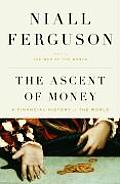 And in his latest book, “The Ascent of Money” — humbly subtitled “A Financial History of the World” — Ferguson takes us on an often enlightening and enjoyable spelunking tour through the underside of great events, a lesson in how the most successful great powers have always been underpinned by smart money. “The ascent of money has been essential to the ascent of man,” he writes, making a conscious reference to the BBC production he loved as a boy, Jacob Bronowski’s “Ascent of Man.”
And in his latest book, “The Ascent of Money” — humbly subtitled “A Financial History of the World” — Ferguson takes us on an often enlightening and enjoyable spelunking tour through the underside of great events, a lesson in how the most successful great powers have always been underpinned by smart money. “The ascent of money has been essential to the ascent of man,” he writes, making a conscious reference to the BBC production he loved as a boy, Jacob Bronowski’s “Ascent of Man.”“Behind each great historical phenomenon there lies a financial secret,” Ferguson says. He goes into fascinating detail about how “it was Nathan Rothschild as much as the Duke of Wellington who defeated Napoleon at Waterloo” by selling bonds and stockpiling gold for the British Army. The richest bankers on the Continent in the 19th century, the Rothschilds became known as die Finanzbonaparten (the Bonapartes of finance). And, as Ferguson argues, they also played a crucial part in the South’s defeat in the Civil War by declining to invest in Confederate cotton-collateralized bonds.
Imperial Spain amassed vast amounts of bullion from the New World, but it faded as a power while the British and Dutch empires prospered because they had sophisticated banking systems and Spain did not. Similarly, the French Revolution was made all but inevitable by the machinations of an unscrupulous Scotsman named John Law, whom the deeply indebted French monarchy recklessly placed in charge of public finance.
“It was as if one man was simultaneously running all 500 of the top U.S. corporations, the U.S. Treasury and the Federal Reserve System,” Ferguson writes. Law proceeded to single-handedly create the subprime mortgage bubble of his day. When it collapsed, the fallout “fatally set back France’s financial development, putting Frenchmen off paper money and stock markets for generations.”
To read the complete review, see: Follow the Money (http://www.nytimes.com/2008/12/28/books/review/Hirsh-t.html)
RESEARCHER CONFIRMS BALTIMORE TOKEN AS CIVIL WAR ISSUE
Russ Sears writes: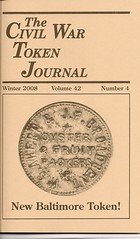 We continue to enjoy The E-Sylum and thank you for producing it.
We continue to enjoy The E-Sylum and thank you for producing it.I thought I would mention my wife Jane's article about a newly attributed Baltimore Civil War token appeared in the Winter 2008 issue of The Civil War Token Journal. It is titled "Proof at Last - Ahern & Broadbent Civil War Token". Jane searched many Civil War era newspapers and other sources in order to locate the advertisements when the company began and ended, as well as detailed histories about Mr. Ahern and Mr. Broadbent. Since there was not a city directory for Baltimore in 1864, it was not possible to merely locate the company in a directory.
We are working with George Fuld and John Ostendorf on Baltimore tokens which should be added to the book on Civil War tokens. John has taken on a large task being the coordinator, and has been working very hard.
MORE ON CORNELIUS VERMEULE
Dennis Tucker of Whitman Publishing writes:
From time to time over the course of the project, I would receive one of Vermeule's trademark "postcards in the round" --- instead of writing from left to right in traditional fashion, he would start at a point and spiral his text around until its conclusion. A unique way of communicating, from a decidedly unique communicator!
| 'Extraordinary Merit' NLG Award Winner Coin Collecting Boards of the 1930s & 1940s: A Complete History, Catalog & Value Guide. $39.95 plus $5 shipping Buy directly from the author and get your copy signed. I also sell my several other books. POB 110022 Lakewood Ranch, FL 34211-0022 | 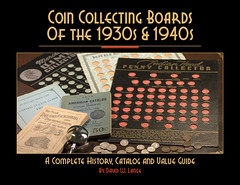 Visit my website: |
SCULPTOR ROBERT GRAHAM 1938-2008
 Robert Graham, a California sculptor whose works were incorporated into civic monuments including the Franklin Delano Roosevelt Memorial in Washington, D.C., has died at the age of 70.
Robert Graham, a California sculptor whose works were incorporated into civic monuments including the Franklin Delano Roosevelt Memorial in Washington, D.C., has died at the age of 70.Graham, who also created monuments to boxer Joe Louis and jazz legends Charlie Parker and Duke Ellington, died on Saturday at Santa Monica UCLA Medical Center and Orthopaedic Hospital.
At his side were his wife, Oscar-winning actress Anjelica Huston, and other members of his family.
"Robert was an amazing sculptor who forever shaped the presence of sculpture art throughout California and the world," California Gov. Arnold Schwarzenegger said in a statement. "His work was truly influential and he will forever remain an icon in this state."
Graham, born in Mexico City, lived much of his life in California and gained fame for designing a ceremonial gateway for the Los Angeles Memorial Coliseum for the 1984 Olympics.
To read the complete article, see: Sculptor Robert Graham dies in California at 70 (http://www.reuters.com/article/newsOne/idUSTRE4BR27X20081228)
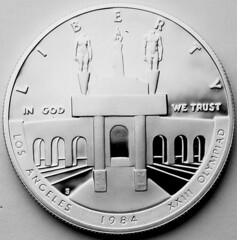
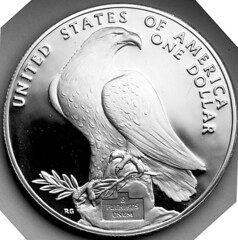
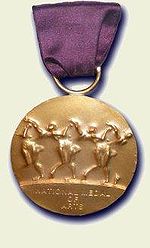
The National Medal of Arts is the highest award given to artists and arts patrons by the United States Government. The National Medal of Arts is awarded by the President of the United States to individuals or groups who, in his judgment, "...are deserving of special recognition by reason of their outstanding contributions to the excellence, growth, support and availability of the arts in the United States."
For more information on the National Medal of Arts, see: National Medal of Arts (http://www.nea.gov/honors/Medals/)
For more information on Robert Graham's work, see: Robert Graham (http://www.robertgraham-artist.com/)
MORE ON THE CSA SILVER INGOTS
Alan W. Weinberg writes:Harold Levi writes:
I spent over six years in research before publishing my book on the Confederate cent, and continue to research today. George Corell has spent nearly thirty years researching a sterling silver Confederate one-fourth coin he owns. During all of this research, neither of us had seen, read or heard of Confederate silver bars until these two appeared.
The Confederacy had both gold and silver bars, which were of Federal (Union) origin. Corell’s research of mint records show that both silver and gold bars were in the New Orleans Mint. Gold bars were in the Dahlonega Mint and, presumably, in the Charlotte Mint. All of this being at the time the Confederacy took control of these mints. C.G. Memminger, CSA Secretary of the Treasury, was opposed to the time and expense it would take to recast these bars or to melt and cast Federal specie. Memminger’s view was that the bars and specie could be used in Europe as they were. The existence of original Confederate gold or silver bars is doubtful.
George Corell adds:
Fred Holabird writes:
There are several suspicious things about these.
a. They resemble no known legitimate ingots
b. They are completely new to the historical record
c. They have come into the marketplace surreptitiously
d. The markings on the ingot have everything wrong with them, and little correct
My cautious and preliminary opinion is that they were made to fool people in an innocent way, in the same manner a souvenir copy, imitation, or creation of an antiquarian piece is made and rendered into the marketplace. Many of us have thoroughly researched ingots produced during the Civil War, primarily from Dahlonega.


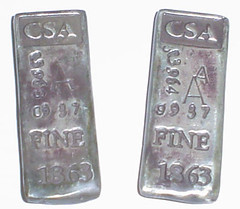
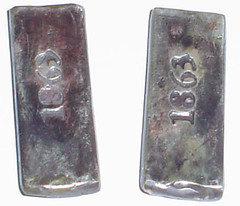
HOLIDAY GREETINGS FROM NEWEST NBS MEMBERS: RICHARD AND GIOVANNI MANTIA
In addition, it followed another wonderful moment, which was my son learning to write for the first time as he turns four and spelling his name in a Christmas card that he gave me. Words can't express that gift!
He'll be reading The Asylum and E-Sylum in no time, but for now I just have him using his crayons to marble the endpapers in some large paper Chapman's and add color to some Heath Counterfeit Detectors. On behalf of my family to you and all the readers, have a safe, healthy, and happy new year. Gratefully with Warmest Wishes, Richard and Giovanni Mantia
THE BOOK BAZARRE
MORE ON BANKNOTES CONTAINED IN BOOKS
The volume entitled Specie-, Kurant- og Rigsbankdaler covering the period from 1788-1845 had tipped-in reprints (from original plates as I understand it) of notes in two groups. The first is the complete 1819 issue starting at p. 328 and proceeding on consecutive pages: 100, 50, 10 5 1 Rigsbankdaler. The second at pages 422 and 424 consists of only two notes, a 50 Rigsbankdaler of 1834 and a 5 of 1836. All of these have four lines of text and dates on their plain backs indicating that they belong to this particular book.
The volume entitled Solv-og Guldmontfod `845-1914 is a thinner book but contains more notes than the other one. Starting on p.74 and in scattered locations are the following uniface prints: 100 Rigsbankdaler face 1845, then the back of that note, followed by the back of the 50 of 1850. Then come face and back of the 20, also of 1850. A few pages later are face and back of the 10 of 1860, also the face of the 5 of 1863.
Further into the book, starting on p. 212, comes the 500 face of 1875; a little later the back appears. This is immediately followed by the 100 face and back of 1875, also the 50 face and back and 10 face of the same issue. Then appear face and back of the 50 of 1883 and 100 of 1888. These are followed by face and back of the 10 of 1891 and 5 of 1898.
All of the above have yellow text tying them to this particular volume, as did those from the earlier book. But the last two notes in this book are truly extraordinary, as they are uniface 500 and 100 dollars pieces from the Bank of St. Thomas. These are made from plates engraved by New England Bank Note Company, and neither print has any text at all on the back.
I have seen one or two of these offered on the banknote market at very substantial prices. I believe they would be recognizable as coming from this book because of the rust spots on the plate showing up on the note as some dark spotting, lightly on the 100 but more so on the 500.
I do not believe any other of the Wilcke volumes has any tipped-in note images.
QUERY: IS SAND SEREF SANS SERIF?
MORE ON THE NEW YORK NUMISMATIC CLUB
Alan V. Weinberg writes:At this show or perhaps the 1962 show , I was up on the balcony overlooking the bourse floor where the exhibits were placed. I gazed for quite a while at a magnificent multi-case display of classic American coinage in the highest grades, my nose almost touching the case glass. "Do you like what you see?" asked a formally-dressed elderly man about 5' 6" who was looking over my shoulder. He introduced himself as Harold Bareford, the owner of the display.
The name meant nothing to me at the time, but he sure had great coins - classic early federal coinage I aspired to own someday...and now do. In 1961-62, R.L. Miles had his entire collection on display on this balcony. Word was, and as evidenced by many of the early copper coins on display, Miles cleaned most of his coins - an all-too-common occurrence in those days when toning was out and "bright" was in. Shortly thereafter, Miles auctioned his extensive U.S. collection thru Stack's.
POLITICS AND THE IRAQI SHOW-THROWING INCIDENT
Regarding the Huey Long medal mentioned last week, Neil Shafer writes:Dan Hamelberg writes:
Long was most likely punched out by a disgruntled citizen. Further, it would not be unreasonable to assume that Long may have said something in the bathroom to deserve his treatment. The circumstances surrounding the Baghdad incident are hardly similar. We may certainly disagree on the reasons for the U.S. military occupation of Iraq, but at least a vote was taken in Congress, and it appears for now that no payoffs or bribes were involved in the process. Also, the shoe thrower was most likely not a US citizen, and probably motivated by his own agenda.
We should try to keep the E-Sylum apolitical. The next time you have an "opportunity to discuss one of [your] favorite medals," you might think about keeping the motivation free from politics.
But since you brought it up, how about a "Free Construction Medal" in honor of the great Senator from Alaska. Or, who wouldn't like a Cheney "Shotgun Medal"? How about an Illinois governor's medal commemorating "Pay for Play"? Then of course, we could design a New York Governor medal of.......well, we probably don't want to go there.
George M. Vanca of Santa Clarita, CA writes:
The next item is also of an unavoidable political nature. Let's all heed Dan's advice and keep our comments off politics and on numismatics. -Editor
OBAMA OFFICIAL INAUGURAL MEDAL IN LIMBO
Although there are a plethora of Obama-themed "coins" and collectibles out in the marketplace, there seems to be no word yet on the official inaugural medal for incoming President Barack Obama. Joe Levine's Presidential Coin & Antique Company has been a national distributor for the Official Inaugural Medal since 1973. I asked Joe about the new medal, but apparently nothing has been decided, at least officially. A number of private firms have submitted designs to the inaugural committee, but none has been chosen and nothing is known of the plans to strike and market them. Attempts to reach key decision-makers on the committee have been met with silence.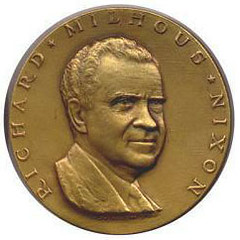
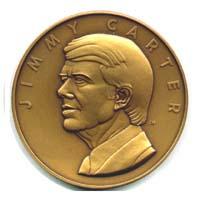
If any of our readers hear any word about the new medal, please let us know. Meanwhile, here's a nice piece Joe wrote about the history of the Official Inaugural Medal. It's in the web site of Lori and Steve Ferber.
History of the Official Inaugural Medal (http://www.loriferber.com/Inaugural_Medals.htm)
THE BOOK BAZARRE
SEPT. 2, 1904: THE DENVER MINT OPENS FOR BUSINESS
"The exercises took place on the roof of the new building. They were simple and brief, and the new flag which will hereafter fly from the great pole on the top of the new building was raised by three veterans of the civil war."
Maybe it was the fact that the mint was another over-budget, much-delayed government project that pushed it to the back of the paper, as if to the back of everyone's minds. The site for the new mint was bought in 1896 and construction began in 1897.
Before departing the same night on the Union Pacific, Director of the Mint Roberts prodded state officials about production.
Beginning in 1860, to handle the millions of dollars in gold and silver pouring into the city from the mines, the enterprise of Clark, Gruber & Company pressed gold coins and ingots in an office at 16th and Market streets. In 1863, that became the United States Assay Office. But even though the building was equipped with coining machinery, not a single coin was ever struck there.
Congress postponed the making of coins in Denver, citing, according to one official, " ... the hostility of the Indian tribes along the routes, doubtless instigated by rebel emissaries (there being a Civil War) and bad white men."
To read the complete article, see: Sept. 2, 1904: Coins begin rolling at mint (http://www.rockymountainnews.com/news/2008/dec/23/sept-2-1904-coins-begin-rolling-mint/)
| FEATURED IN OUR JANUARY 10, 2009 NEW YORK PUBLIC AUCTION SALE ANDREWS' EXTREMELY RARE 1881 VARIETIES OF U. S. CENTS, 1816-57 FROM THE HARRY W. BASS LIBRARY GEORGE FREDERICK KOLBE Email: GFK@numislit.com Tel: (909) 338-6527 | 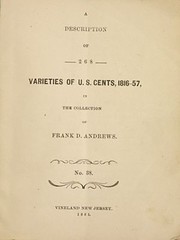 |
WOODBRIDGE "BUFFALO NICKEL CLAY MODEL" ACTUALLY AN ORNAMENTAL MEDALLION
Yoi! - This is what people think is a Fraser original for the Buffalo nickel?? Here are some excerpts from the article. -Editor
The thick, clay nickel made of terra cotta was unveiled in front of township officials and members of the Historical Association of Woodbridge Township and the township Historical Preservation Commission earlier this month.
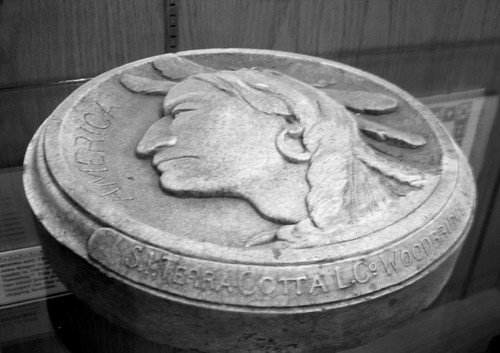
The owner of the historic nickel, Gordon Henderson, let the township borrow the piece to allow township residents and visitors to observe a piece of history.
"It's still my piece," Gordon Henderson reminded township officials at the unveiling.
Henderson, a third-generation stained-glass artist, said he could have sold the piece along the way, but had realized the importance of the terra cotta industry in Woodbridge.
Henderson, who will turn 90 years old in January, said he remembers seeing the original 1913 Indian Head Buffalo nickel, which he has held onto all these years, when he was a young boy.
"It was always around the house on the shelves," said Henderson, who grew up in Rutherford. "My father had acquired it around 1929 and I have kept it in storage all these years."
Henderson said he became a collector like his father.
"I displayed my work and the coin at the [Jane Voorhees] Zimmerli Art Museum at Rutgers University in New Brunswick," he said.
The oblique angle photo accompanying the article shows a left-facing Indian portrait in exaggerated relief, compared to the nickel’s right-facing, low relief portrait. Additionally, the photo shows the manufacturer’s name “S.I. Terra Cotta L. Co. Woodbridge” along the lower bevel of the piece. The portrait is crudely modeled and certainly not intended for close examination, let alone use on a coin.

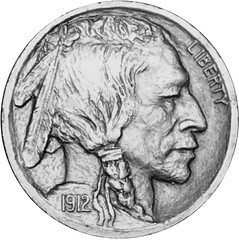
Left: terracotta decorative medallion;
Right: model for the Buffalo nickel by James Fraser.
There is no connection between the crude clay medallion and the Buffalo nickel.
A non-numismatic writer can be excused minor liberties, however it is amazing that no Woodbridge-area coin collectors were consulted who could have helped avoid an embarrassing situation for the town.
What the Sentinel article claims is the “…original clay mold used to mint the first 1913 Indian Head Buffalo nickel” is actually a terra cotta ornamental medallion. These were made for use as decoration on the façade of buildings, particularly banks and financial companies.
There are several similar ornamental medallions on the U.S. Mint headquarters building in Washington, DC. They are, of course, much better done and closely resemble several real coins.
To read the complete article, see: Town celebrates antique coin mold (http://ws.gmnews.com/news/2008/1223/front_page/004.html)
BLOGGER CLAIMS EVIDENCE OF NEW "AMERO" BANK NOTES
In September, 2007 - over a full year ago - I first broke the story about AMERO coins being minted secretly at the Denver Mint. After that story ran, the Denver Mint announced on its web site that they were closing public tours of the Mint for 10 - 14 days in order to make renovations to the tourist area of the mint.
My sources inside the Mint, however, reported Treasury officials were outraged that someone had leaked info about the AMERO to me and they closed the Denver Mint to the public so as to secretly move the AMEROS out of the Mint to prevent further leaks.
In October, 2008, I received word that the U.S. government shipped 800 Billion AMEROS to the China development bank. I did a story on that (here) and obtained an actual AMERO coin from that shipment!
I placed a video of the coin on YouTube, showing the coin and explaining that there is a deliberate effort underway at the highest levels of our government to intentionally exhaust the dollar as a currency. Over 600,000 people worldwide watched that video.
Two days ago, YouTube/Google notified me that my video had been deleted and my account permanently closed at the request of the United States Treasury Department. The Treasury department told YouTube/Google that my video was "destabilizing the U.S. Dollar and was thus a threat to national security."
Here we are, just two days later and my sources have once again come through; this time with proof the government is secretly printing new AMERO paper currency.
Not only do I have the 50 AMERO note, give look at the 20 and 100 AMERO notes below!

This AMERO currency will allow the government to literally grab 90% of all our life savings and owe 90% less than they presently do in one fell swoop! They get out of debt and the rest of us are left totally destitute. Broke. Busted. Poor. Helpless.
*** URGENT *** NEW "AMERO" PAPER CURRENCY EXPOSED! (http://community.allhiphop.com/go/thread/view/12461
/5523805/WTFSO_THIS_IS_HOW
_THE_NEW_AMERICA_DOLLAR_WILL_LOOK_IN_2009)
To read the earlier E-Sylum Amero articles, see:
CONSPIRACY THEORISTS HOME IN ON AMERO FANTASY COINS (http://www.coinbooks.org/esylum_v10n36a23.html)
MORE ON DANIEL CARR'S AMERO COINS (http://www.coinbooks.org/esylum_v10n37a12.html)
MORE ON THE AMERO: MEXICO'S VINCENTE FOX DISCUSSES TRADE UNION (http://www.coinbooks.org/esylum_v10n41a17.html)
ECUADOR TALKS OF ELIMINATING U.S. DOLLAR
An E-Sylum reader writes:Economists fear the leftist Correa will scrap the dollar to better deal with an economy reeling from plummeting oil prices and limited foreign credit after he defaulted on $3.8 billion in sovereign bonds over illegalities charges.
"It will be really stupid to scrap the dollar," Correa said during his weekly media address. "Our government has done more than anyone to protect the dollarized (economy)."
The dollar, adopted as Ecuador's currency in 2000 to halt devaluations after a crippling financial crisis, is widely popular among Ecuadoreans who see it as an anchor of economic stability.
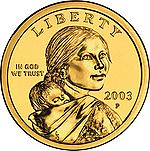
Many uninformed Ecuadorians believe the central device on the obverse is that of an Ecuadorian woman from the mountains.
To read the earlier E-Sylum article, see: SACAGAWEA DOLLARS IN ECUADOR (http://www.coinbooks.org/esylum_v10n34a16.html)
FEATURED WEB PAGE: THE MONEY OF THE CIVIL WAR
This week's Featured Web Page on the Money of the Civil War is recommended by John and Nancy Wilson. From the web site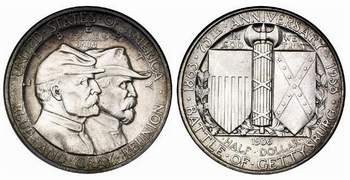
www.us-coin-values-advisor.com/civil-war-coins.html

